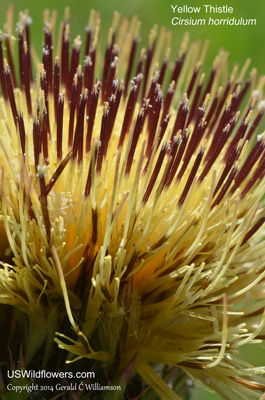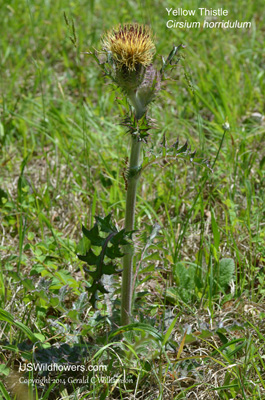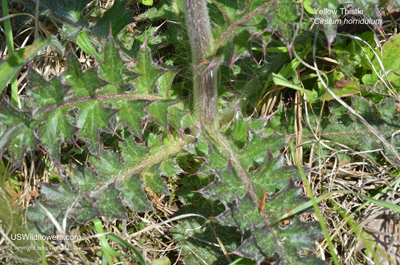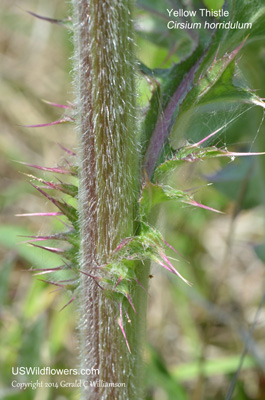Yellow Thistle, Common Yellow Thistle, Spiny Thistle, Bigspine Thistle, Southern Yellow Thistle, Horrible Thistle - Cirsium horridulum
|
Cirsium horridulum - Yellow Thistle, Common Yellow Thistle, Spiny Thistle, Bigspine Thistle, Southern Yellow Thistle, Horrible Thistle. Most of the plants we normally call thistles are within four genera in Asteraceae, Carduus, Cynara, Cirsium, and Onopordum. The vast majority of the species of thistle found in North America - and all the native ones - are in the Cirsium genus. With over 60 species in the genus in North America there is at least one in every state, and the genus is represented throughout most of Canada as well.
Cirsium horridulum, Yellow Thistle, is an eastern species, being found in all of the eastern coastal states from Maine to Texas as well as in Tennessee, Arkansas, and Oklahoma. It grows in open areas such as roadsides, meadows, and pastures. While Cirsium horridulum, along with all species of Cirsium, are considered noxious weeds in Arkansa, and many (most?) people look on it as such, it receives protection as an Endangered or Threatened species in Connecticut, New Hampshire, Pennsylvania, and Rhode Island. There are three varieties of the species in the United States - vars. horridulum, vittatum, and megacanthum. Var. horridulum is the only one with yellow flowers, but it can also have red to purple flowers. The other two varieties have a narrower distribution in the U.S., and are less hairy than var. horridulum.
Found in:
AL, AR, CT, DE, FL, GA, LA, MA, MD, ME, MS, NC, NH, NJ, NY, OK, PA, RI, SC, TN, TX, VA
Leave comments on Cirsium horridulum at this link. | 
Distribution of Cirsium horridulum in the United States and Canada:

Blue=Native; Grey=Introduced
Map from USDA Plants Database:
USDA, NRCS. 2017. The PLANTS Database (http://plants.usda.gov, 16 Jan 2025). National Plant Data Team, Greensboro, NC 27401-4901 USA.
Search Our Database: Enter any portion of the Scientific, Common Name, or both.
Do a general Google search of the entire site:
#ad
 Follow USWildflowers on Twitter
#ad
| | Site: Chickamauga Battlefield, Catoosa County, Ga Date: 2014-May-12 | Photographer: Gerald C. Williamson
Nikon D7000
Tamron SP 90MM f/2.8 AF Macro | | The flower head of Yellow Thistle can be fairly large, and is subtended by a whorl of spiny, leaflike bracts. These bracts are usually quite hairy in var. horridulum. The bracts are sparsely hairy or glabrous in the other two varieties. | | 
| | Site: Chickamauga Battlefield, Catoosa County, Ga Date: 2014-May-12 | Photographer: Gerald C Williamson
Nikon D7000 | | Cirsium horridulum is among the rayless members of Asteraceae. The corollas may be up to nearly 2 inches long. Var. horridulum is the only variety in the species with yellow flowers. The corollas of the flowers of this species may also be reddish, lavender, or purple. I’m still trying to understand the ribbed reddish structure that is extending from the corolla and appears to be encapsulating the pistil and stamens. | | Click on the photo for a larger image

| | Site: Chickamauga Battlefield, Catoosa County, Ga Date: 2014-May-12 | Photographer: Gerald C Williamson
Nikon D7000 | | Yellow thistle grows to as much as 5 or more feet tall (var. megacanthum can be up to 8 feet tall.) The spiny stem leaves are alternate and are may be unlobed but dentate, or deeply pinnately lobed. Depending on the variety, the leaves may be densely to slightly tomentose or even glabrous. | | Click on the photo for a larger image

| | Site: Chickamauga Battlefield, Catoosa County, Ga Date: 2014-May-12 | Photographer: Gerald C Williamson
Nikon D7000 | | Yellow Thistle has a basal rosette of leaves present at flowering. | | Click on the photo for a larger image

| | Site: Chickamauga Battlefield, Catoosa County, Ga Date: 2014-May-12 | Photographer: Gerald C Williamson
Nikon D7000 | | Cirsium horridulum var. horridulum has a densely hairy stem. The other varieties are much less hairy - sparsely tomentose to glabrous. | | Click on the photo for a larger image

|
References used for identification and information:
|
|
| |
| #ad
|
|







